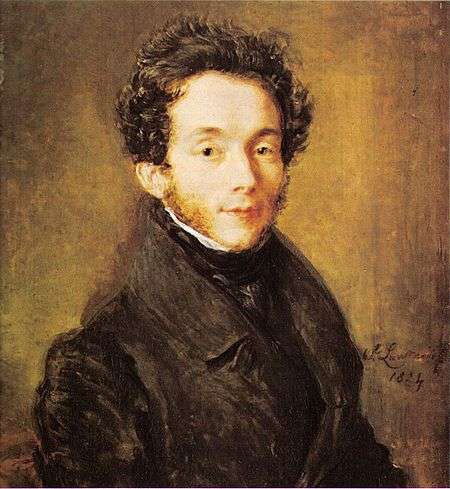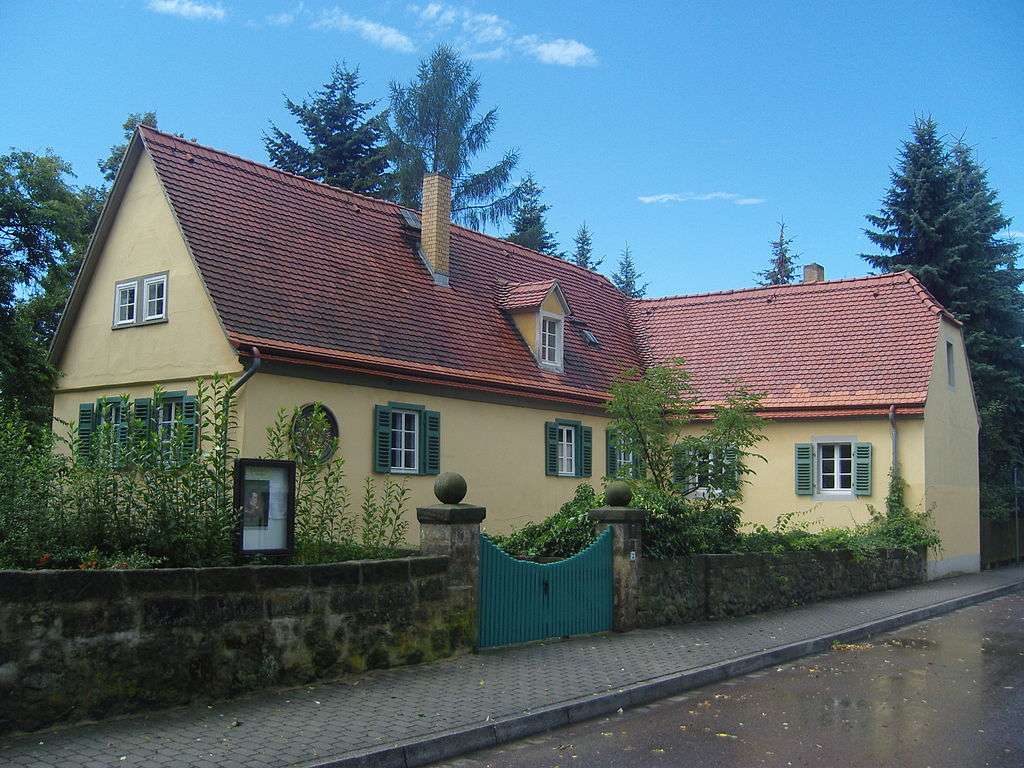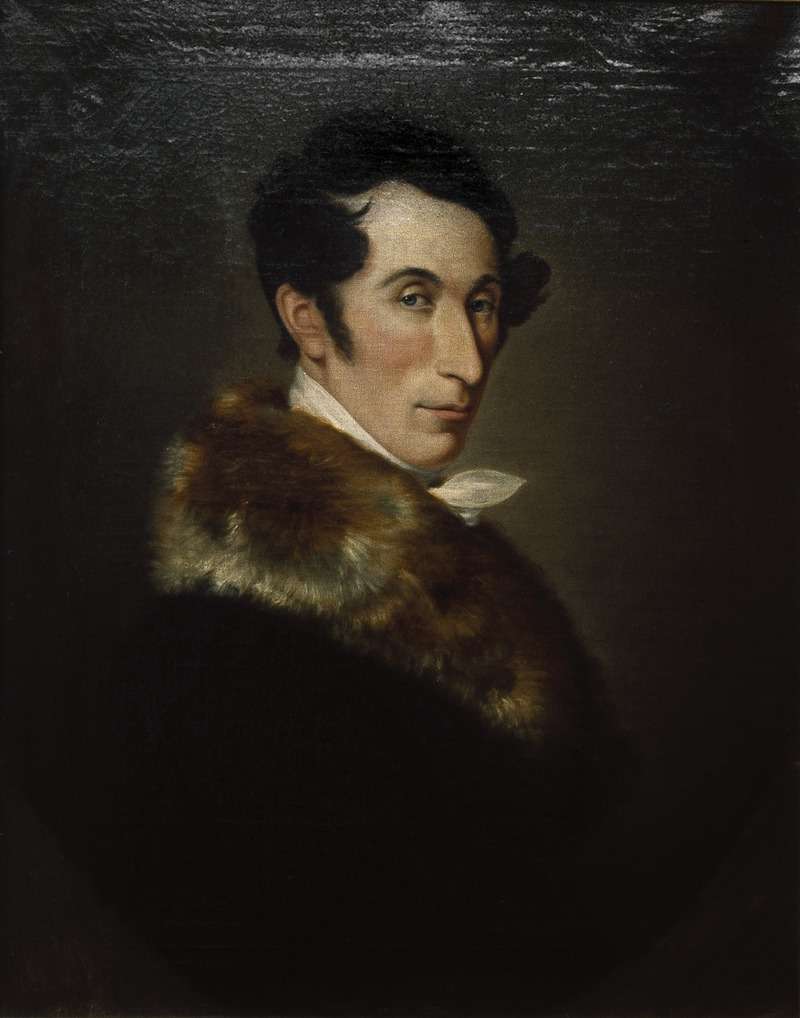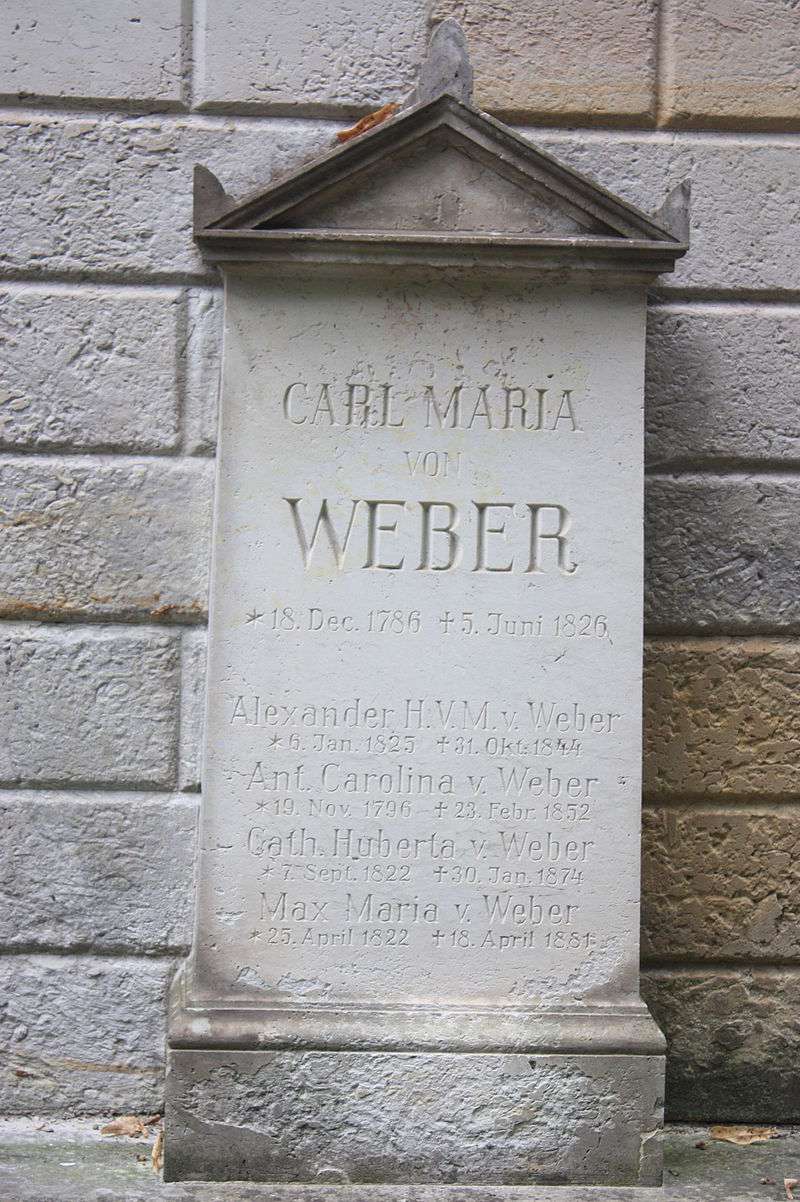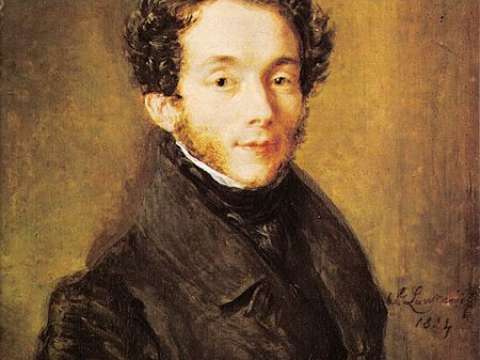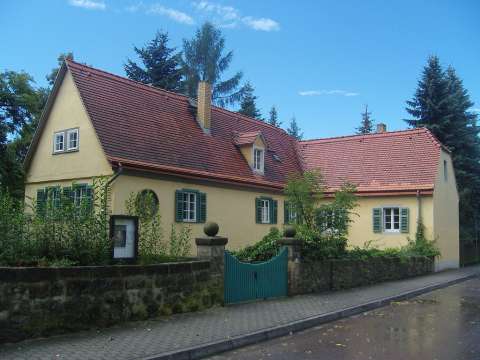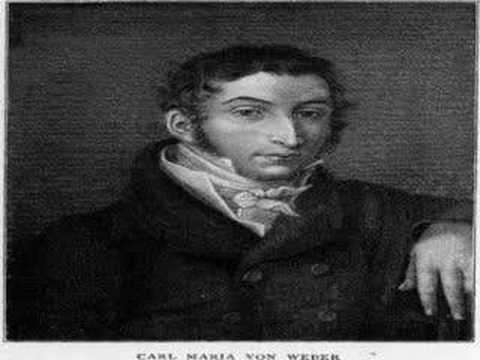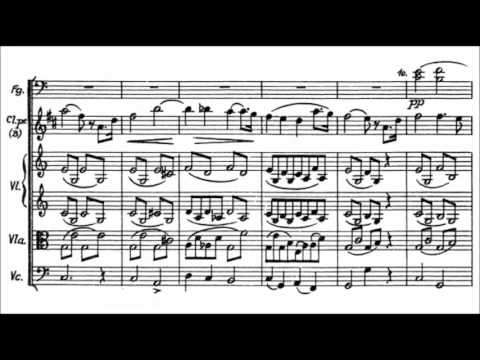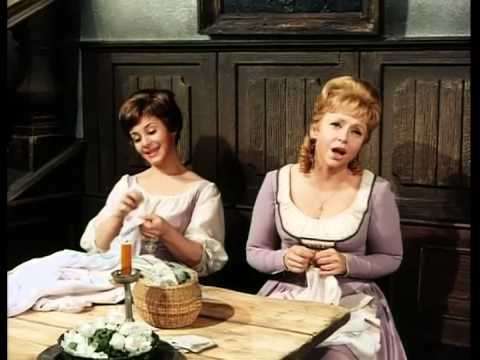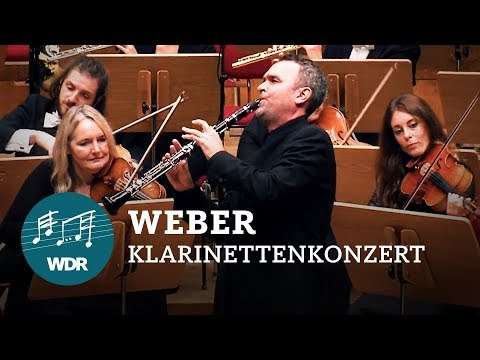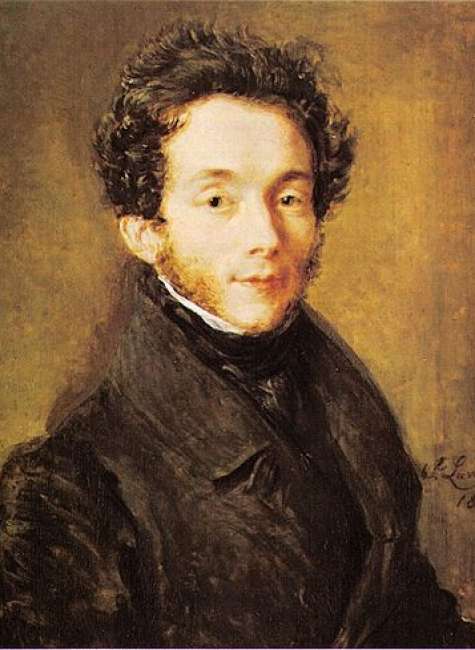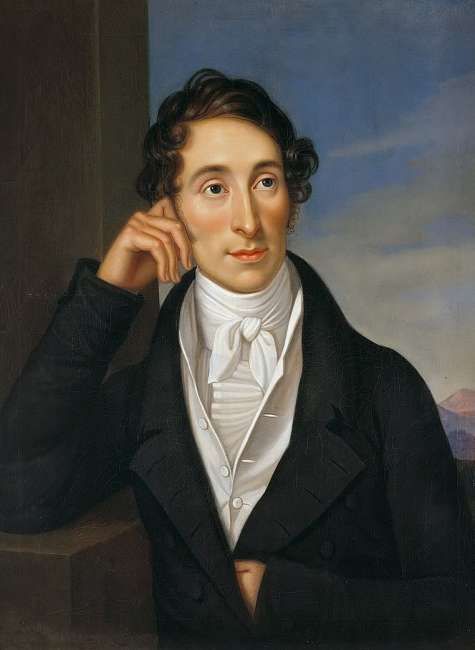

Carl Maria von Weber (1786-1826)
What love is to man, music is to the arts and to mankind. Music is love itself - it is the purest, most ethereal language of passion, showing in a thousand ways all possible changes of color and feeling; and though true in only a single instance, it yet can be understood by thousands of men - who all feel differently.
Carl Maria von Weber was a German composer, conductor, virtuoso pianist, guitarist and critic who was one of the first significant composers of the Romantic era. Best known for his operas, he was a crucial figure in the development of Romantische Oper Romantic opera.
Throughout his youth, his father, Franz Anton , relentlessly moved the family between Hamburg, Salzburg, Freiberg, Augsburg and Vienna. Consequently he studied with many teachers – his father, Johann Peter Heuschkel, Michael Haydn, Giovanni Valesi, Johann Nepomuk Kalcher and Georg Joseph Vogler – under whose supervision he composed four operas, none of which survive complete. He had a modest output of non-operatic music, which includes two symphonies; a bassoon concerto; piano pieces such as Konzertstück in F minor and Invitation to the Dance; and many pieces that featured the clarinet, usually written for the virtuoso clarinetist Heinrich Baermann. His mature operas – Silvana 1810, Abu Hassan 1811, Der Freischütz 1821, Die drei Pintos comp. 1820–21, Euryanthe 1823, Oberon 1826 – were a major influence on subsequent German composers including Marschner, Meyerbeer, and Wagner; his compositions for piano anticipated those of Chopin and Liszt. His best known work, Der Freischütz, remains among the most significant German operas.
Life and career
Childhood
Weber was born in Eutin, Bishopric of Lübeck, as the eldest of the three children of Franz Anton von Weber and his second wife, Genovefa Weber, a Viennese singer. He was baptized Catholic on November 20, 1786 with the name Carl Friedrich Ernst; the alternative second name Maria appeared only later. His brother and sister died in infancy. Both parents were Catholic and originally came from the far south of Germany. The "von" was an affectation of his father, who was not an aristocrat.
In April 1779, Franz Anton had been appointed director of the prince-bishopric orchestra, Eutin, which, however, was dissolved in 1781 because of spending cuts. He then took the position of Eutin's municipal music director. Dissatisfied with this position, he resigned in 1787 and founded a theatre company in Hamburg. After a brief stay in Vienna, he joined the theatre company of Johann Friedrich Toscani and Peter Carl Santorini, who performed in Kassel, Marburg and Hofgeismar. He tried repeatedly to establish a lasting company of his own but had only intermittent success.
Franz Anton's half-brother, Fridolin, married Cäcilia Stamm and had four daughters, Josepha, Aloysia, Constanze and Sophie, all of whom became notable singers. Wolfgang Amadeus Mozart attempted to woo Aloysia, composing several pieces for her. But, after she rejected his advances, Mozart went on to marry Constanze; thus Mozart's wife was a cousin of Carl Maria von Weber.
A gifted violinist, Franz Anton had ambitions of turning Weber into a child prodigy like Mozart. Weber was born with a congenital hip disease and did not begin to walk until he was four. But by then, he was already a capable singer and pianist.
Education
Franz Anton gave Weber a comprehensive education, which was consistently interrupted by the family's frequent moves. In 1796, Weber continued his musical education in Hildburghausen, where he was instructed by the oboist Johann Peter Heuschkel. After moving to Salzburg in autumn 1797, Weber studied from 1798 with Michael Haydn, younger brother of the better known Joseph Haydn, who agreed to teach Weber free of charge.
His time in Salzburg was overshadowed by the death of his, who succumbed to tuberculosis on 13 March 1798, and that of his one-year-old sister Antonetta on 29 December 1798 in Munich.
A visit to Joseph Haydn in Vienna, presumably in hope of advanced teaching, was fruitless. In autumn 1798, Weber moved to Munich where he studied singing with Johann Evangelist Wallishauser and composing with Johann Nepomuk Kalcher, who supervised Weber's first opera, Die Macht der Liebe und des Weins The Power of Love and Wine. Like his other compositions of that period, this opera is lost. Six fughettas for piano of the twelve-year-old Weber were published in Leipzig.
Weber's musical education was extended by a mastering of lithography which he learned in the workshop of Alois Senefelder, the inventor of the process, and Franz Gleißner autumn 1799. A set of his Variations for the Pianoforte was lithographed by Weber himself.
In 1800, the family moved to Freiberg in Saxony, where Weber, then 14 years old, wrote an opera called Das stumme Waldmädchen The Silent Forest Maiden. It was produced at the Freiberg and Chemnitz theatres and later in Saint Petersburg 1804, Vienna 1805/1805 and Prague 1806. The young Weber also began to publish articles as a music critic, for example in the Leipziger Neue Zeitung in 1801.
In 1801, the family returned to Salzburg, where Weber resumed his studies with Michael Haydn. Weber composed his third opera Peter Schmoll und seine Nachbarn Peter Schmoll and His Neighbours which his teacher approved. After a concert tour in 1802 the Webers returned to Augsburg where it is believed Peter Schmoll premiered.
In mid 1803, Weber continued his studies in Vienna with Abbé Vogler, founder of important music schools in Mannheim, Stockholm, and Darmstadt. Another famous pupil of Vogler in Darmstadt was Jakob Meyer Beer, later known as Giacomo Meyerbeer, who became a close friend of Weber. In letters they addressed each other as "brother".
Early career 1804–1810
Vogler recommended the 17-year-old Weber for the post of Director at the Breslau Opera in 1804; Weber was offered and accepted the post. He sought to reform the Opera by pensioning off older singers, expanding the orchestra, and tackling a more challenging repertoire. His ambitious and dedicated work as director of the orchestra was acknowledged, though his tempi were frequently criticized as too fast. As the daily routine did not leave sufficient time for his own creative work, Weber did not seek to extend his two-year appointment.
After an interlude at the court of Duke Eugen of Württemberg, who resided in Silesia, Weber served from 1807 to 1810 in Stuttgart as private secretary to Duke Ludwig, brother of King Frederick I of Württemberg. Weber's time in Württemberg was plagued with troubles. He fell deeply into debt and became entangled in the financial manipulations of his employer, e.g. the sale of confirmations of ducal service which exempted the purchaser from military service. Weber was arrested and charged with embezzlement and bribery. As he could disprove the allegations, the case was brought under civil law to avoid compromising the de facto manipulator, the brother of the king. Weber agreed to pay the costs the last payment was made in 1816 and was banished from Württemberg/ together with his father.

As a sobering side effect, Weber started to keep a diary to list his expenses and correspondence, and make occasional comments on special events.
Weber remained prolific as a composer during this period, writing a quantity of religious music, mainly for the Catholic mass. This, however, earned him the hostility of conservatives working for the re-establishment of traditional chant in liturgy.
Later career 1810–1826
In 1810, Weber visited several cities throughout Germany; 1811 was a pivotal year in his career when he met and worked with the Munich court clarinetist Heinrich Baermann and composed the Concertino in E♭ Major, Op. 26, J. 109, and the two concerti J. 114 and J. 118 for him; from December 1811 through March 1812, Weber went on tour with Baermann playing the clarinet works, and it was some of the final concerts on this tour that changed public, critical and royal opinions of Weber's work, and helped him to mount a successful performance of Silvana in Berlin later that year. From 1813 to 1816 he was director of the Opera in Prague; from 1816 to 1817 he worked in Berlin, and from 1817 onwards he was director of the prestigious Opera in Dresden, working hard to establish a German opera, in reaction to the Italian opera which had dominated the European music scene since the 18th century. On 4 November 1817, he married Caroline Brandt, a singer who created the title role of Silvana. In 1819, he wrote perhaps his most famous piano piece, Invitation to the Dance.
The successful premiere of Der Freischütz on 18 June 1821 in Berlin led to performances all over Europe. On the very morning of the premiere, Weber finished his Konzertstück in F minor for Piano and Orchestra, and he premiered it a week later.

In 1823, Weber composed his first and only full-length, through-composed opera Euryanthe to a libretto by Helmina von Chézy, several passages of which notably the music for the villainous couple Lysiart and Eglantine anticipate the early, romantic operas of Richard Wagner. In 1824, Weber received an invitation from The Royal Opera, London, to compose and produce Oberon, based on Christoph Martin Wieland's poem of the same name. Weber accepted the invitation, and in 1826 he travelled to England, to finish the work and conduct the premiere on 12 April.
Weber was already suffering from tuberculosis when he visited London. He conducted the premiere and twelve sold-out performances of Oberon in London during April and in May, and despite his rapidly worsening health, he continued to fulfil commitments for private concerts and benefits.

He died in his sleep during the night on 5 June 1826 at the home of his good friend and host Sir George Smart; he was 39 years old. He was buried in London.
Eighteen years later, in December 1844, his remains were transferred to the family burial plot in the Old Catholic Cemetery Alter Katholischer Friedhof in Dresden at the side of his youngest son Alexander, who at the age of 19 had died of measles seven weeks before. The simple gravestone, designed by Gottfried Semper, lies against the northern boundary wall. The eulogy at the reburial was delivered by Wagner.
Weber's unfinished opera Die drei Pintos The Three Pintos was originally given by his widow to Meyerbeer for completion; it was eventually completed by Gustav Mahler, who conducted the first performance in Leipzig on 20 January 1888.
Legacy
Weber's operas Der Freischütz, Euryanthe and Oberon greatly influenced the development of the Romantische Oper Romantic opera in Germany. Der Freischütz came to be regarded as the first German opera, Euryanthe developed the leitmotif technique to an unprecedented degree, while Oberon may have influenced Mendelssohn's music for A Midsummer Night's Dream and, at the same time, revealed Weber's lifelong interest in the music of non-Western cultures. This interest was first manifested in Weber's incidental music for Schiller's translation of Gozzi's Turandot, for which he used a Chinese melody, making him the first Western composer to use an Asian tune that was not of the pseudo-Turkish kind popularized by Mozart and others.
Weber's compositions for clarinet, bassoon, and horn occupy an important place in the musical repertoire. His compositions for the clarinet, which include two concertos, a concertino, a quintet, a duo concertante, and variations on a theme from his opera Silvana, are regularly performed today. His Concertino for Horn and Orchestra requires the performer to simultaneously produce two notes by humming while playing—a technique known as "multiphonics". His bassoon concerto and the Andante e Rondo ungarese a reworking of a piece originally for viola and orchestra are also popular with bassoonists.

Weber's contribution to vocal and choral music is also significant. His body of Catholic religious music was highly popular in 19th-century Germany, and he composed one of the earliest song cycles, Die Temperamente beim Verluste der Geliebten Temperaments on the Loss of a Lover. Weber was also notable as one of the first conductors to conduct without a piano or violin.
Weber's orchestration has also been highly praised and emulated by later generations of composers – Berlioz referred to him several times in his Treatise on Instrumentation while Debussy remarked that the sound of the Weber orchestra was obtained through the scrutiny of the soul of each instrument.
His operas influenced the work of later opera composers, especially in Germany, such as Marschner, Meyerbeer and Wagner, as well as several nationalist 19th-century composers such as Glinka. Homage has been paid to Weber byMany 20th-century composers paid homage to Weber, such as Debussy and Stravinsky. Mahler completed Weber's unfinished comic opera Die drei Pintos and made revisions of Euryanthe and Oberon while Hindemith composed the popular Symphonic Metamorphosis of Themes by Carl Maria von Weber, based on Weber's lesser-known keyboard works and the incidental music to Turandot.
Weber also wrote music journalism and was interested in folksong, and learned lithography to engrave his own works.
A virtuoso pianist himself, Weber composed four sonatas, two concertos and the Konzertstück in F minor concert piece, which influenced composers such as Chopin, Liszt and Mendelssohn. The Konzertstück provided a new model for the one-movement concerto in several contrasting sections such as Liszt's, who often played the work, and was acknowledged by Stravinsky as the model for his Capriccio for Piano and Orchestra. Weber's shorter piano pieces, such as the Invitation to the Dance, were later orchestrated by Berlioz, while his Polacca Brillante was later set for piano and orchestra by Liszt. However, Weber's piano music all but disappeared from the repertoire. There are several recordings of the major works for the solo piano, including complete recordings of the piano sonatas and the shorter piano pieces, and there are recordings of the individual sonatas by Claudio Arrau 1st sonata, Alfred Cortot and Emil Gilels 2nd sonata, Sviatoslav Richter 3rd sonata and Leon Fleisher 4th sonata. The Invitation to the Dance, although better known in Berlioz's orchestration as part of the ballet music for a Paris production of Der Freischütz, has long been played and recorded by pianists e.g., Benno Moiseiwitsch . Invitation to the Dance also served as the thematic basis for Benny Goodman's swing theme song for the radio program Let's Dance.
More facts
45 Years (2015)
The Intouchables (2011)
The Game Plan (2007)

